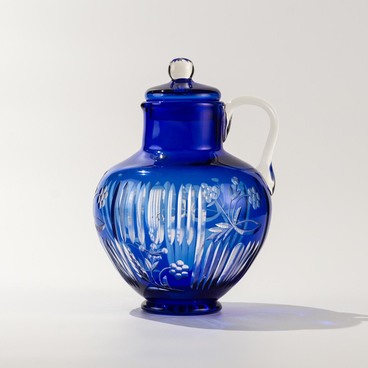The “Tree” vase was made of colorless glass in the late 19th century using the pressing technique. The first hand-operated mechanical pressing device was invented in England in 1826, and by 1838, it had been introduced at the Dyatkovo Crystal Factory, which was quite a unique industrial innovation for that time.
The Dyatkovo Crystal Factory was the first factory in Russia to master the production of pressed glassware. Pressing is a precise, simple, efficient, and cost-effective method of forming glass products. When the pressing technique is used, the images (facets) and their unique design are shaped using a mold when the glass mass is hot. There are both single-piece and split (multi-component) molds which are made of metal and heated using a gas burner during the shaping process. The mold and the glass mass should be heated to approximately the same temperature of around 1200 ºС. When the pressed item is hard enough, it is extracted by using a portable tray or by toppling the mold over and put into a lehr for annealing.
The Dyatkovo craftsmen put a lot of work into making the forms and decoration of mass-produced everyday objects more aesthetically pleasing. The technologists, engineers, and craftsmen conducted numerous tests at the Dyatkovo Crystal Factory to develop their own expressive means of pressed glassware. The “Tree” vase is an example of the search for new techniques, shapes, and textures. It depicts a tree standing firmly on the ground, with its interwoven trunks supporting the treetop which serves as a frilled bowl for fruit, cookies, and sweets. The “Tree” vase is a brilliant example of the Art Nouveau style that was incredibly popular in late 19th century Russia. This style was characterized by using the shapes of natural objects, plants, and animals, as interpreted by the artist. The Art Nouveau glass was the artistic genre that helped to bring together advanced technologies and natural beauty, mass production and high aesthetic ideals. Antique glass items of the Art Nouveau style became one of the pinnacles of glass art and continue to spark interest among scientists and collectors alike.
The Dyatkovo Crystal Factory was the first factory in Russia to master the production of pressed glassware. Pressing is a precise, simple, efficient, and cost-effective method of forming glass products. When the pressing technique is used, the images (facets) and their unique design are shaped using a mold when the glass mass is hot. There are both single-piece and split (multi-component) molds which are made of metal and heated using a gas burner during the shaping process. The mold and the glass mass should be heated to approximately the same temperature of around 1200 ºС. When the pressed item is hard enough, it is extracted by using a portable tray or by toppling the mold over and put into a lehr for annealing.
The Dyatkovo craftsmen put a lot of work into making the forms and decoration of mass-produced everyday objects more aesthetically pleasing. The technologists, engineers, and craftsmen conducted numerous tests at the Dyatkovo Crystal Factory to develop their own expressive means of pressed glassware. The “Tree” vase is an example of the search for new techniques, shapes, and textures. It depicts a tree standing firmly on the ground, with its interwoven trunks supporting the treetop which serves as a frilled bowl for fruit, cookies, and sweets. The “Tree” vase is a brilliant example of the Art Nouveau style that was incredibly popular in late 19th century Russia. This style was characterized by using the shapes of natural objects, plants, and animals, as interpreted by the artist. The Art Nouveau glass was the artistic genre that helped to bring together advanced technologies and natural beauty, mass production and high aesthetic ideals. Antique glass items of the Art Nouveau style became one of the pinnacles of glass art and continue to spark interest among scientists and collectors alike.

